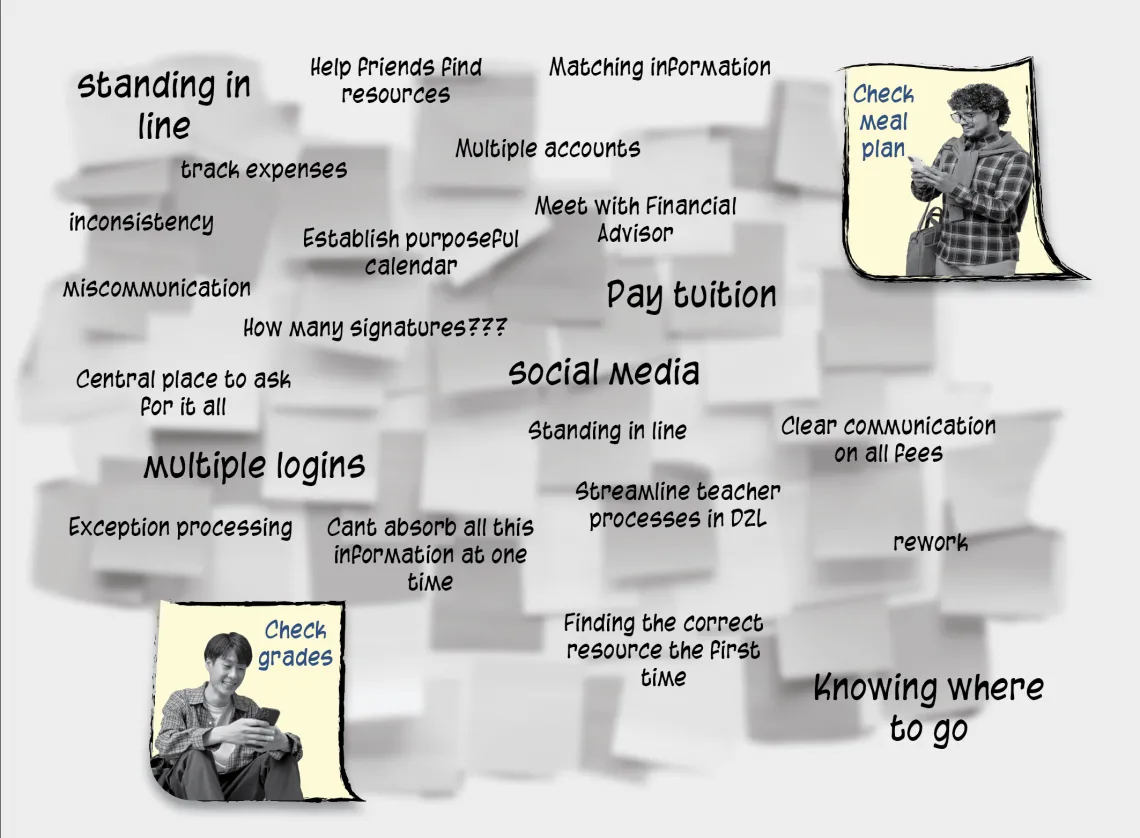Digital Experience Technologies
The Student Digital Journey
The modern-day digital experience that is the norm for today’s students at the University of Arizona is far from what it used to be five years ago. Back then, it was a patchwork of manual processes sprinkled with applications, some on-line, some requiring multiple paper forms, many requiring signatures. It was equivalent to the best available in the early 2000s, but student expectations have changed dramatically since then. In October 2018, the University’s Strategic Plan initiative, Institutional Excellence, helped drive change to the more high-quality consumer experience our students enjoy today.
Identifying the needs of students has included several student journey mapping sessions over the course of the past five years. These sessions helped the Digital Experiences staff identify trends, patterns, and opportunities where they could create an impact in the daily lives of students. Students, faculty and volunteers from 23 of the university’s functional departments came together to identify pain points for first year University of Arizona students. These sessions include journey-mapping sessions, empathy mapping, surveys, short campus intercept polling, and design studios. Through these collaborative efforts the team found many of the pain points were attributed to a lack of integration and student-centric design. As a result, several thematic areas of student activity and interaction were identified as opportunities for fostering digital transformation and design approaches to everyday student interactions with the university.
Information to and from students was often pointed to as being misaligned and chaotic. Complaints about students having to go from one office to another for an answer to a question were commonplace. It also became clear that students didn’t see school and personal life as two different things. They wanted to be able to use their digital device for everything. Not knowing where to find resources, was brought up again and again, as students came to campus used to a customized, streamlined experience where their resource finds them: (think Amazon or Google] But finding resources was often a challenge back then, especially when it came to contacting and meeting with their advisor.
Students asked for a single location where all their resources could be found and exercised. Back then, tracking their enrollment, student fees, bursars account and meal plan meant navigating multiple applications. Students wanted a central place to ask for it all and communication with resources in ways that work for them, one student joking about needing, a chat bot or text system for campus resources like a Siri who went to the University.”
Administrative staff and leadership came to realize their view of the university mirrored organizational structures and did not match how students experience problems and look for solutions. For faculty and staff, it was time consuming to match information to student. Finding the correct resources for students the first time was fraught with rework, miscommunication and exception processing. Communication between resource advisors was a telephone call, email or paper trail at best. These failings of the overall system caused errors and frustration for everyone.
The solution to address these issues was the implementation of a customer relationship management platform to host reusable, repeatable sets of core capabilities that could be mix and matched for whatever the individual organization needs, with no direct cost to the unit.
Today we have Trellis Advise and Trellis Progress both accessible through a new CatCloud portal. CatCloud offers students the convenience of managing various activities from UArizona systems in one place. The CatCloud portal allows them to customize their user experience making it easier to access information that matters to them.
A major change for students was the ability to schedule appointments with advisors, see their CatCash balance and Bursar Accounts, view their assignments, quizzes and grades, and a use new direct channel by which to contact their faculty and instructors.
The University of Arizona is actively working to modernize and unify the digital experience for both students and employees. Recognizing the ever-evolving nature of technology, the Digital Experience Technologies team realizes expectations will continue to change, inspiring them to find new ways to serve students, faculty and staff at the university.

FY23 Metrics
Trellis CRM
Total Active Users in Trellis CRM
1,239
Early Progress Reports Sent
22,135
Number of Courses
840
Appointments Scheduled
120,071
Case Management
Service Cases Created
233,481
Trellis Events
Unique Event Creators
95
Trellis Marketing Cloud
Total Active Users
393
All Units: Individual Emails Sent
18.5M
Campus Web Services
Websites Supported
755
Website Launched
227
Service Requests
807
SERVICES
- Campus Web Services
- Trellis Service
- Trellis Engagement
- Employee Email & Collaboration
- Student Email & Collaboration
- Video Conferencing
- Arizona Mobile App
“Students asked for a single location where all their resources could be found and accessed. Today we have CatCloud.”
